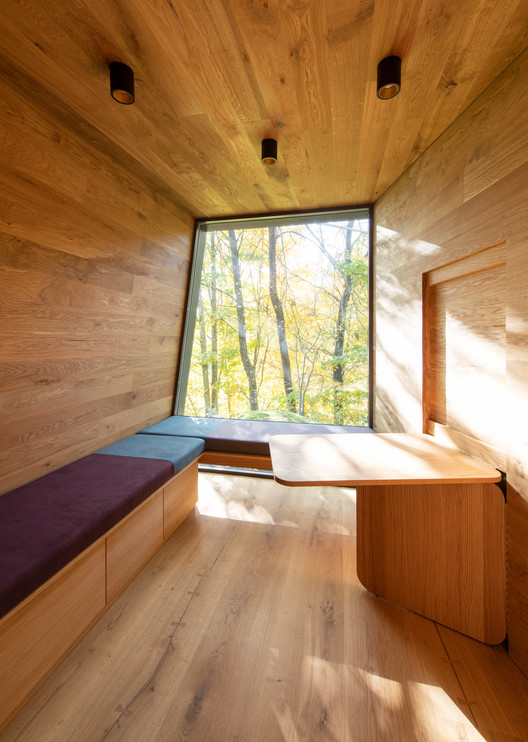House D Hohensinn Architektur
2014-01-29 01:00


架构师提供的文本描述。D房位于北山坡上,是一座所谓的“奥祖肖”,它是奥地利人对一座曾经被用作“退休”农民的住宅的建筑的表达,将农场移交给他们的继承人。
Text description provided by the architects. Situated on a slightly sloping northern hillside, House D is a so called Auszugshaus, which is an Austrian expression for a building once used as a residence for “retired” farmers after turning over the farm to their heirs.
© Sebastian Schels
塞巴斯蒂安·谢尔斯


传统的Innviertel农舍是由农场周围的一个广场组成的建筑,由于其位于果园和屋外的位置,大多环绕在“软”边缘。D房的设计是基于这样的理念,即以较小的规模来处理农家的主题,并创造一个更加简约、紧凑的基本形式,并规划一个开放的空间供私人使用。
The traditional Innviertel farmhouse consists of buildings arranged in a square around the farmyard, mostly skirted by “soft” edges due to its location amidst orchards and outhouses. House D’s design is based on the idea of taking up the farmyard theme on a smaller scale and to create a more austere and compact basic form with an open area planned for private use.
© Sebastian Schels
塞巴斯蒂安·谢尔斯


针对山坡的情况,从街道、车库、储藏室、衣帽间到房子的入口,以及客房,都建在一楼,建在山坡上。从那里,一段通往楼上的楼梯可以直接进入开放式厨房和一个从内庭院打开的起居区,从而面向南。这栋建筑的L形西侧与起居区相连,提供两间卧室、一间浴室、一间公用室和一间衣橱。
In response to the hillside situation, the entrance to the house from the street, garage, storage rooms and cloakroom, and a guestroom, are all on the ground floor, which is built into the hillside. From there, a flight of stairs leading to the upper floor provides direct access to the open-plan kitchen and a living area that opens up on the inner courtyard, thus facing south. Linked to the living area, the L-shaped western wing of the building offers two bedrooms, a bathroom, a utility room and a walk in wardrobe.
© Sebastian Schels
塞巴斯蒂安·谢尔斯


开放空间的面积稍微升高,以创造一个反向梯度,从而自然地将它融入景观,并形成一个准确的边缘之间的房子和它的周围。它被划分为不同的区域:悬臂屋顶下的座位区、菜园和草坪都有助于形成一个多样化和紧凑的外部区域,提供多种用途。
The open space area was slightly elevated to create a reverse gradient, thus naturally integrating it into the landscape and forming an accurate edge between the house and its surroundings. It is divided into different zones: the seating area beneath the cantilevered roof, vegetable garden and lawn all contribute to a diverse and compact outer area that offers a variety of uses.
© Sebastian Schels
塞巴斯蒂安·谢尔斯


这座房子由一层木结构组成,内部可见,它位于钢筋混凝土地下室地板上。用未经处理的杉木制成的足球场用于传统的农业建筑,形成了相当安静、几乎封闭的区域。只有那些对着内院的人才是深灰色的。相比之下,白色的门框和窗框有节奏地活跃了庭院地区的外墙。
The house consists of a laminated timber construction that is visible in the interior and that rests on a reinforced concrete basement floor. Façades made of untreated fir wood, as used for traditional agricultural buildings, form rather quiet, almost closed areas. Only those facing the inner courtyard are glazed in dark grey. By contrast, the white door and window frames rhythmically enliven the outer walls in the courtyard area.
© Sebastian Schels
塞巴斯蒂安·谢尔斯


这座建筑的内部设计和它的外部设计一样不起眼。简单实心的橡木家具部分融入了房间的配置,包括一个与艺术家汉斯·雷纳(Hans Rainer)共同开发的厨房,后者还在一个黑色钢板上安装了一个“漂浮”的瓷砖炉子,让这座房子既具有简约的风格,又具有朴素的个性。
The building’s interior design is just as unostentatious as its exterior. Simple, solid oak furniture that is partially integrated into the room’s configuration, including a kitchen developed together with artist Hans Rainer, who also installed a tiled stove “floating” on a black steel plate, give the house both a minimalist style and homely character.




























Architects Hohensinn Architektur
Location Neuhofen im Innkreis, Austria
Category Houses
Area 244.0 sqm
Project Year 2013
Photographs Sebastian Schels
























